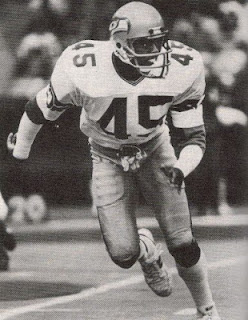Running Back,
Chicago
Age: 31
11th
season in pro football & with Bears
College: Jackson State
Height: 5’10” Weight: 202
Prelude:
Chosen by the
Bears in the first round of the 1975 NFL draft, Payton played hurt during his
rookie season (and missed the only game of his career) as he accumulated 679
rushing yards. He broke out in ’76, running for 1390 yards on a league-leading
311 carries and scoring 13 touchdowns, and followed that up with a MVP season
in 1977 in which he rushed for 1852 yards, including a then-record 275 in a
single game. Over the course of the next seven seasons, Payton rushed for over
a thousand years in all but strike-shortened 1982 and led the NFC in rushing
for five straight years, despite being part of a lackluster offense that had
opposing teams keying on him. In 1984 he surpassed Jim Brown’s NFL career
record of 12,312 rushing yards. Payton was named to the Pro Bowl seven times
and was a consensus first-team All-Pro on four occasions prior to ‘85.
1985 Season Summary
Appeared and
started in all 16 games
[Bracketed
numbers indicate league rank in Top 20]
Rushing
Attempts – 324
[4]
Most
attempts, game - 28 (for 192 yds.) at Green Bay 11/3, (for 53 yds.) at NY Jets
12/14
Yards – 1551 [3]
Most yards,
game – 192 yards (on 28 carries) at Green Bay 11/3
Average gain
– 4.8 [8, tied with James Brooks & Eddie Lee Ivery]
TDs – 9 [8,
tied with Roger Craig & Larry Kinnebrew]
100-yard
rushing games - 10
Pass
Receiving
Receptions – 49
Most
receptions, game – 6 (for 37 yds.) vs. Tampa Bay 9/8
Yards – 483
Most yards,
game - 69 (on 4 catches) vs. Detroit 11/10
Average gain
– 9.9
TDs – 2
Passing
Attempts – 5
Completions –
3
Yards – 96
TDs – 1
Interceptions
– 0
All-Purpose
Yards – 2034 [4]
Scoring
TDs – 11 [9,
tied with Mike Quick]
Points – 66
Postseason: 3 G
Rushing
attempts – 67
Most rushing
attempts, game - 27 vs. NY Giants, NFC Divisional playoff
Rushing yards
– 186
Most rushing
yards, game - 93 vs. NY Giants, NFC Divisional playoff
Average gain
rushing – 2.8
Rushing TDs –
0
Pass
receptions – 8
Most pass
receptions, game - 7 vs. LA Rams, NFC Championship
Pass
receiving yards - 52
Most pass
receiving yards, game – 48 vs. LA Rams, NFC Championship
Average yards
per reception – 6.5
Pass
Receiving TDs - 0
Awards & Honors:
NFL MVP: NEA,
Bert Bell Award
1st
team All-NFL: AP, PFWA, NEA, Sporting News
1st
team All-NFC: UPI
Pro Bowl
Bears went 15-1
to finish first in the NFC Central with the conference’s best record while
leading the NFL in rushing (2761 yards) and NFC in scoring (456 points). Won
NFC Divisional playoff over New York Giants (21-0), NFC Championship over Los
Angeles Rams (24-0), and Super Bowl over New England Patriots (46-10).
Aftermath:
Payton played
two more seasons, and was selected to the Pro Bowl once more in 1986. Not only
a productive ground gainer, he was an outstanding blocker and receiver out of
the backfield, as well as an accomplished passer on option plays (he was even
the club’s emergency quarterback). Payton ultimately totaled 10 thousand-yard
rushing seasons. He was a consensus first-team All-Pro five times and was
chosen to nine Pro Bowls. The even-tempered player known as “Sweetness” was
also an unselfish team leader and hard worker, and was popular not only with
Bears fans, but throughout the league. He retired as the NFL’s all-time leading
rusher with 16,726 yards and also topped the list in carries (3838) and rushing
TDs (110); his total of 125 touchdowns ranked second. Payton also caught 492
passes for 4538 yards and exceeded 2000 yards from scrimmage in four seasons.
The Bears retired his #34 and he was inducted into the Pro Football Hall of
Fame, Class of 1993.
--
MVP Profiles feature players who were named MVP or
Player of the Year in the NFL, AAFC (1946-49), AFL (1960-69), WFL (1974), or
USFL (1983-85) by a recognized organization (Associated Press, Pro Football
Writers Association, Newspaper Enterprise Association, United Press
International, The Sporting News, Maxwell Club – Bert Bell Award, or the league
itself).












